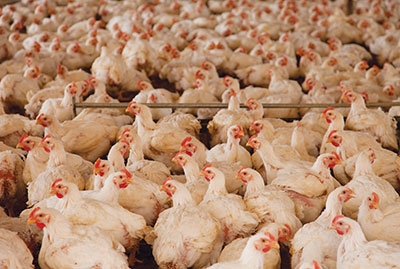
Leg Issues in Meat Birds
By Melanie Epp
Features Broilers Health Poultry Production ProductionIndustry discusses how genetics, feed or hatchery health can play a role
 The cause(s) of leg problems in broilers is complex, and seldom involves just one factor. Everything’s involved from the genetics of the bird to breeder health and nutrition, the operation of the hatchery, physical injury, broiler farm management and broiler nutrition.
The cause(s) of leg problems in broilers is complex, and seldom involves just one factor. Everything’s involved from the genetics of the bird to breeder health and nutrition, the operation of the hatchery, physical injury, broiler farm management and broiler nutrition. At a recent Poultry Industry Council (PIC) Science in the Pub event, producers, scientists and industry men and women gathered to discuss the causes of leg issues in meat birds: feed, genetics or hatchery health issues. Each, it was concluded, plays a role in leg health.
Research shows leg issues during grow-out are one of the major causes of culling and late mortality in heavy broilers. Leg issues don’t just occur during grow-out, though; they are possible during the first few weeks’ of growth as well.
While the incidence of clinical lameness is said to be typically less than 2-3 per cent, broilers that are affected sub-clinically can also experience reduced walking ability, an issue that later affects feed conversion and growth. Economic impacts can extend beyond live production losses, too. In fact, research shows that leg issues can increase costs per kilo of live weight, as well as costs at the processing level. Lame birds, says a 2008 leg heath report by Edgar Rondon of the Department of Poultry Science at North Carolina State University, spend more time lying in litter and bring more contamination to the processing plant. Increased contamination, he says, can create issues at the food safety level.
Birds are tested for their genetic potential – heart-lung function, leg strength, livability and growth – in high-hygiene environments, says Scott Gillingham, Canadian Regional Business Manager for Aviagen Inc.
Breeder Perspective
Rapid growth can cause leg issues in broilers, says Gillingham, which is why Aviagen looks for traits that will provide the best cross for supporting skeletal strength. Highly susceptible birds are not only recorded, but rejected and removed from the breeding program as well, as are those that exhibit either clinical or sub-clinical issues.
“We look at bone deformities, crooked toes, etcetera, as an opportunity under clinical evaluation [to see] whether or not these birds are robust enough to fit the program,” he says.
The breeding program, he says, has been going on for a long time. In fact, the broilers of today are nothing like the broilers of the ‘50s, says Gillingham. Considering today’s yield requirements, birds of that generation wouldn’t make it in the program.
“We have seen leg deformities and improvement in such,” says Gillingham, who suggests that bringing out genetic potential requires more stock. In order to get that stock, he says, the industry must work together.
“I think communication amongst us is critical – nutrition, health, genetics, academia, management, on-farm. We’re going to continue with genetic improvement until you say stop.”
Don Copeland, PIC Vice Chair, agrees with Gillingham about the role of genetics, but thinks that when it comes to leg issues, it’s not just one issue.
Complex Issue
“In my history of broiler growing, there’s very seldom just one isolated cause of leg problems,” says Copeland. This is a very complex issue. Everything’s involved from the genetics of the bird to breeder health and nutrition, the operation of the hatchery, physical injury, broiler farm management and broiler nutrition.”
Hatching a chick is still basically the same, but there are some differences that need to be taken care of, he says. The weak point in a broiler, he continues, is in its legs.
“Anything you do is going to show up in the legs,” he says. “Hatcheries have found with today’s high-yielding type birds that we need to run the hatcheries different than we did. Temperature and humidity settings need to be adjusted to match the new breeds.”
Bacterial Loads
Bacterial loads need to be minimized too, says Copeland, mentioning major bacterial issues, like salmonella and staphylococcus.
“They’re always out there,” he says. “The issue is can you keep the numbers down? It’s a numbers game. If you can minimize it at all the different points in the system, you’re going to get through. If you put that in the bird and then stress the bird, it’s going to show up. It may not be legs – it may be other things – but a lot of them cause these issues.”
Every new generation of broiler is capable of increased growth rates, says Copeland. “It just continues, so we have to adjust the way we are managing for it.”
“Any weakness in the production process from the breeder to the hatchery and into the broiler farm can disrupt the normal growth pattern, and this seems to inevitably show up as a leg problem,” he concludes.
Dr. Blake Wang, Poultry Nutritionist with Wallenstein Feed & Supply Ltd, says that genetics and nutrition can be factors for leg weakness. And more research, he says, is necessary to explore the relationship between incubation conditions and leg problems.
Incubation Distress
There is some research to show that incubation distress also causes leg issues in meat birds, says Wang.
“High incubation temperatures are really bad during the last phase of embryo development. That will affect muscle and bone development. The reason is that high temperatures will speed up embryo growth.”
Ingredients, he says, can also affect leg health, especially rancid fat and undercooked soybean meal. High calcium diets are problematic, too, he says. To minimize issues, Wang suggests that producers evaluate feed, making sure that it isn’t perhaps too good. That and follow their nutritionist’s recommendations.
Print this page